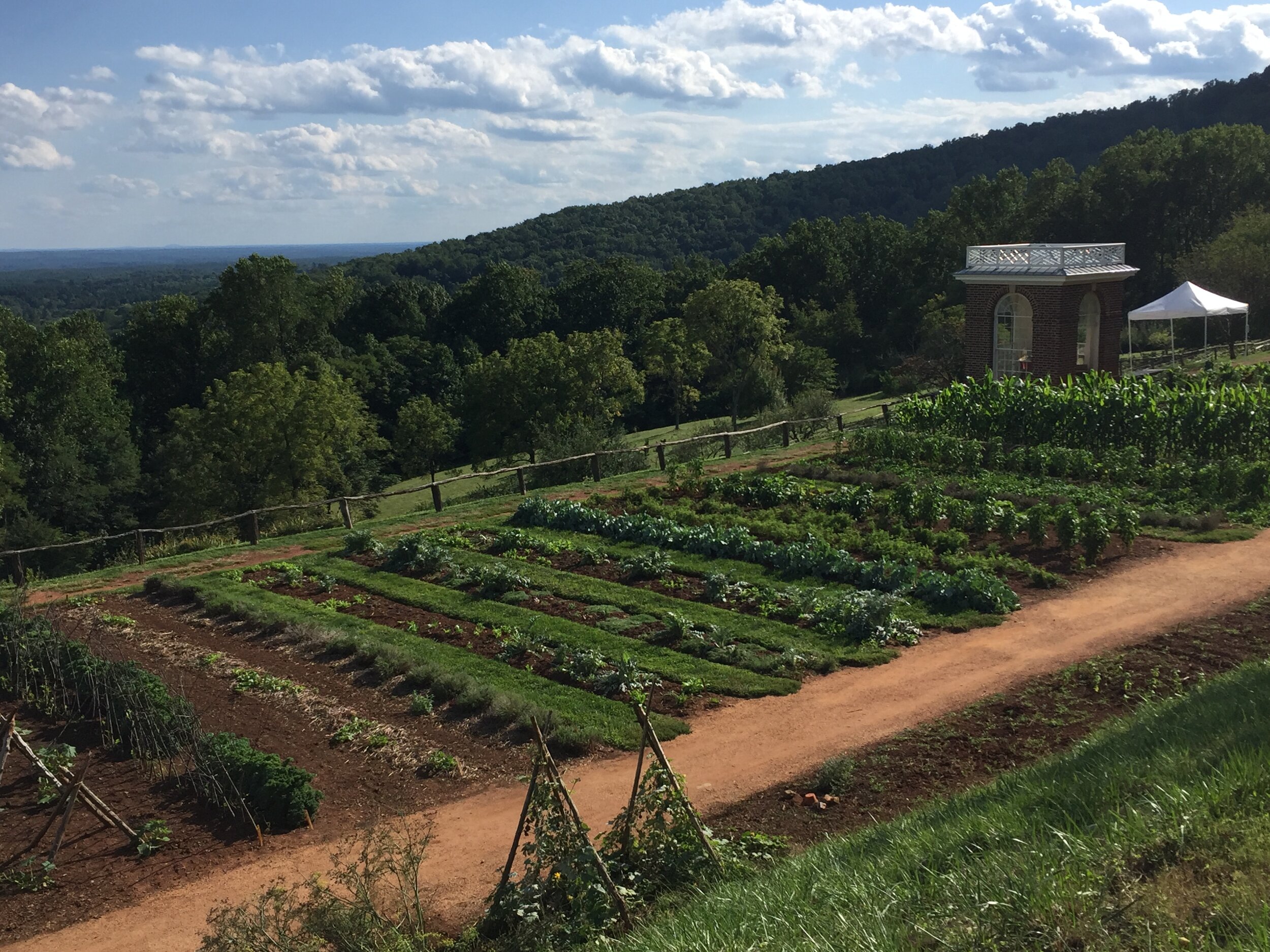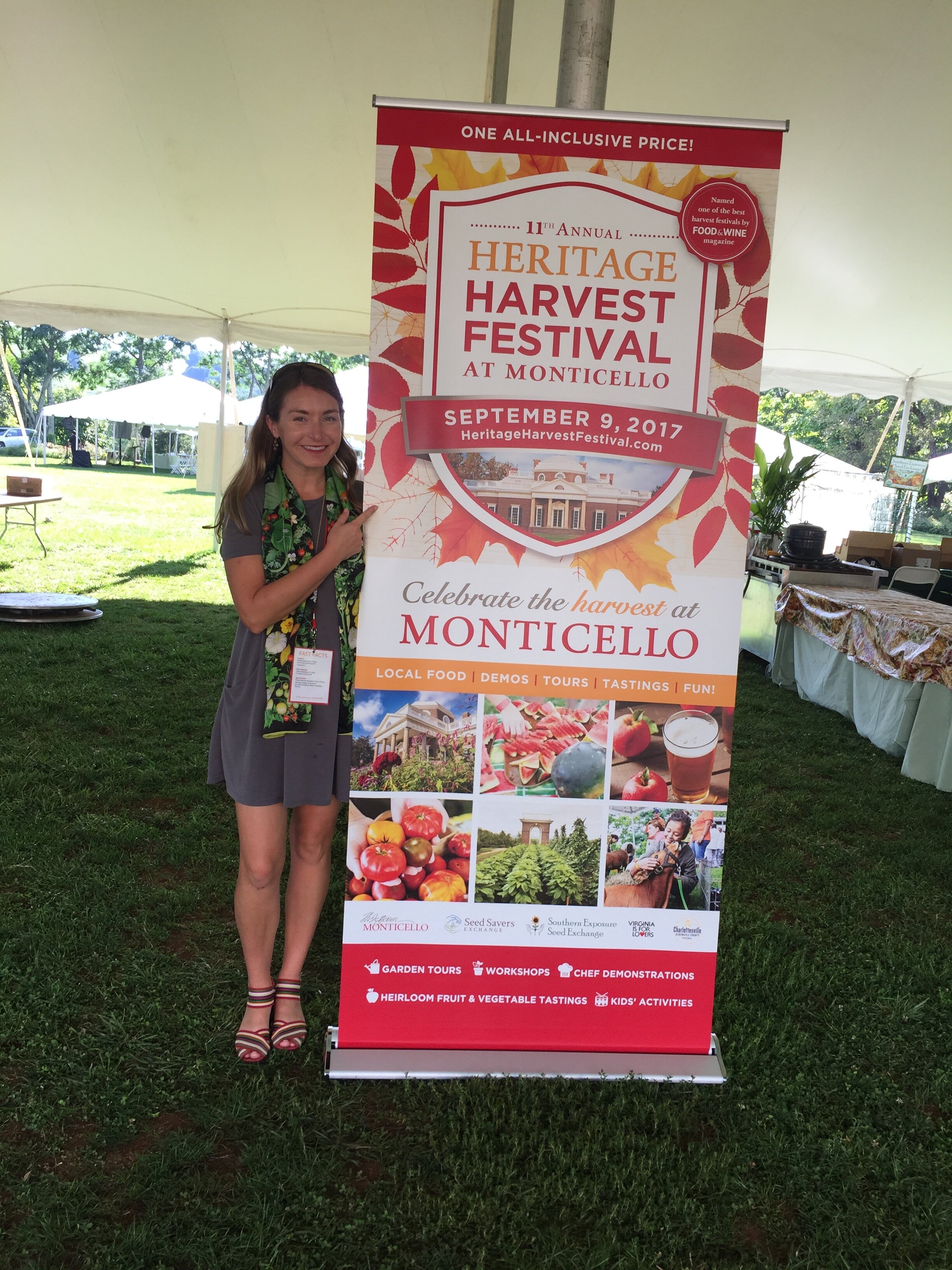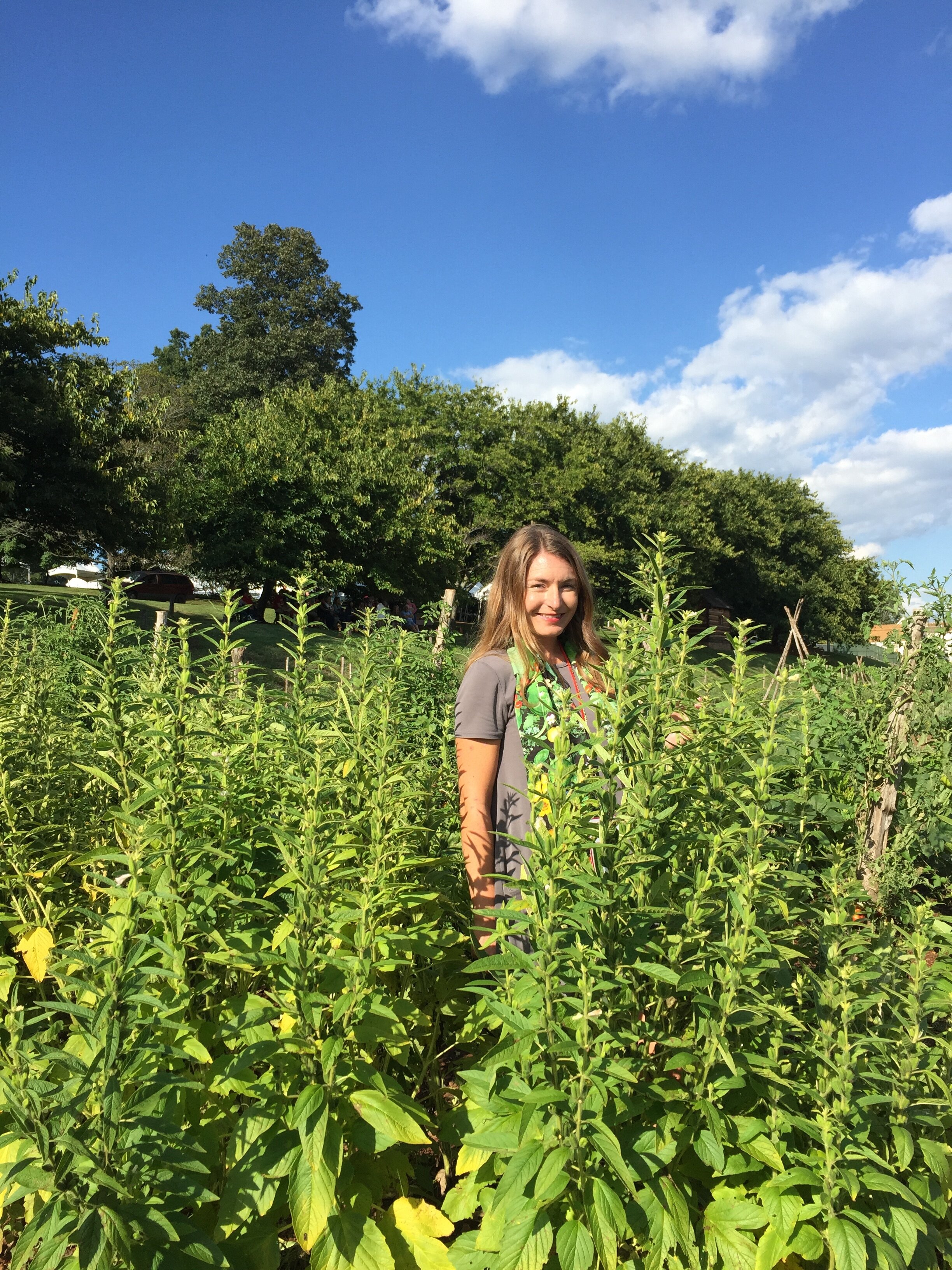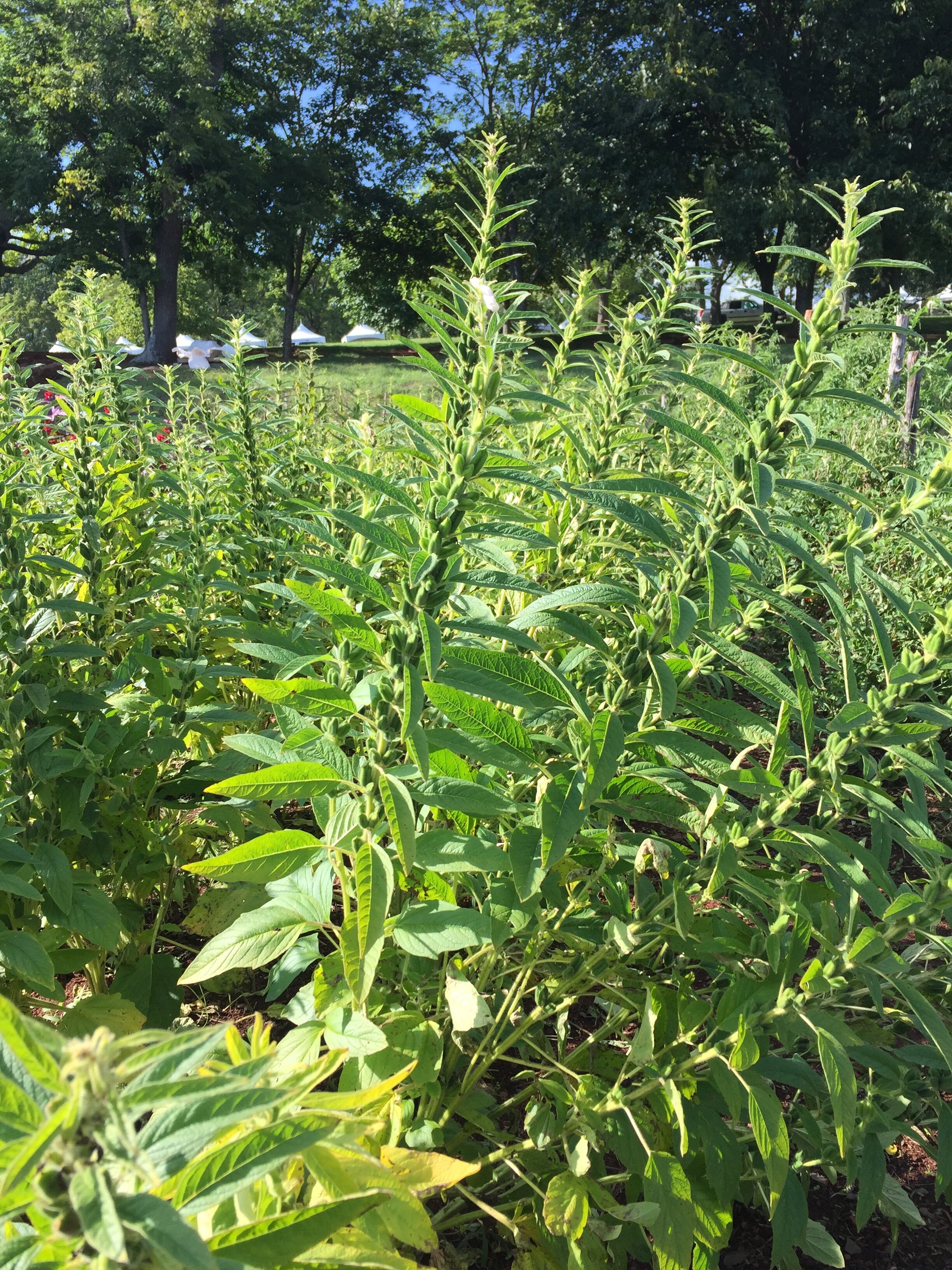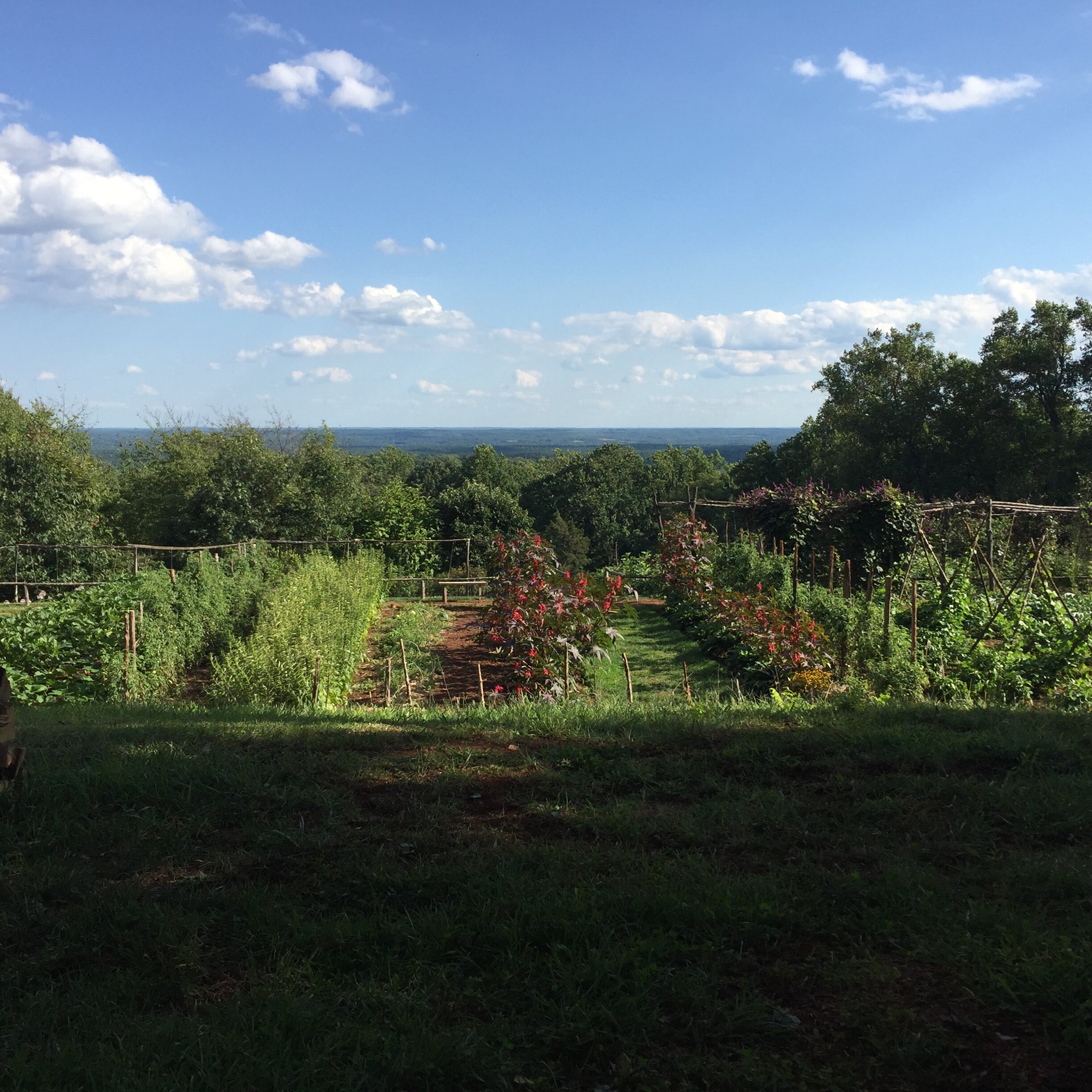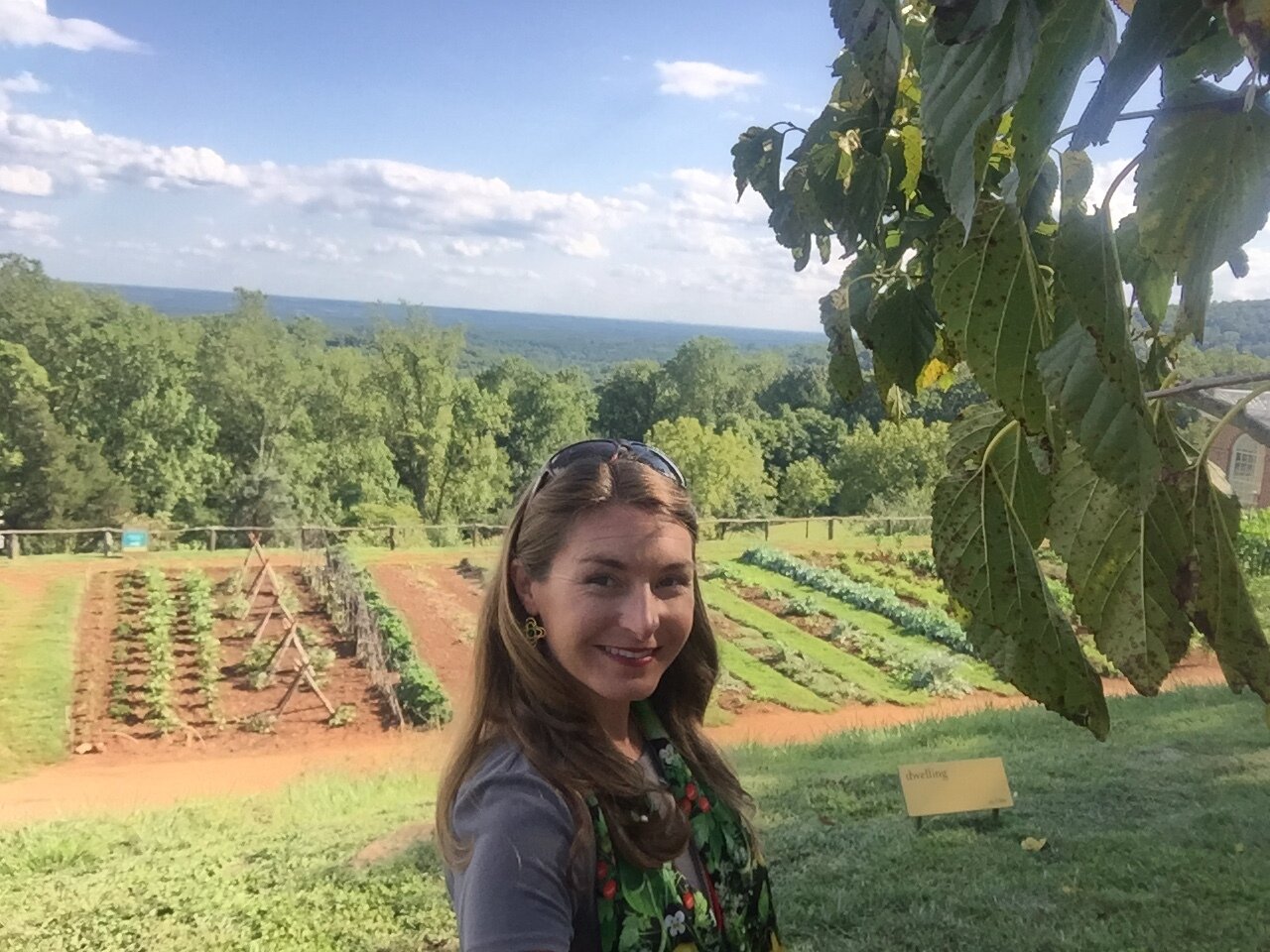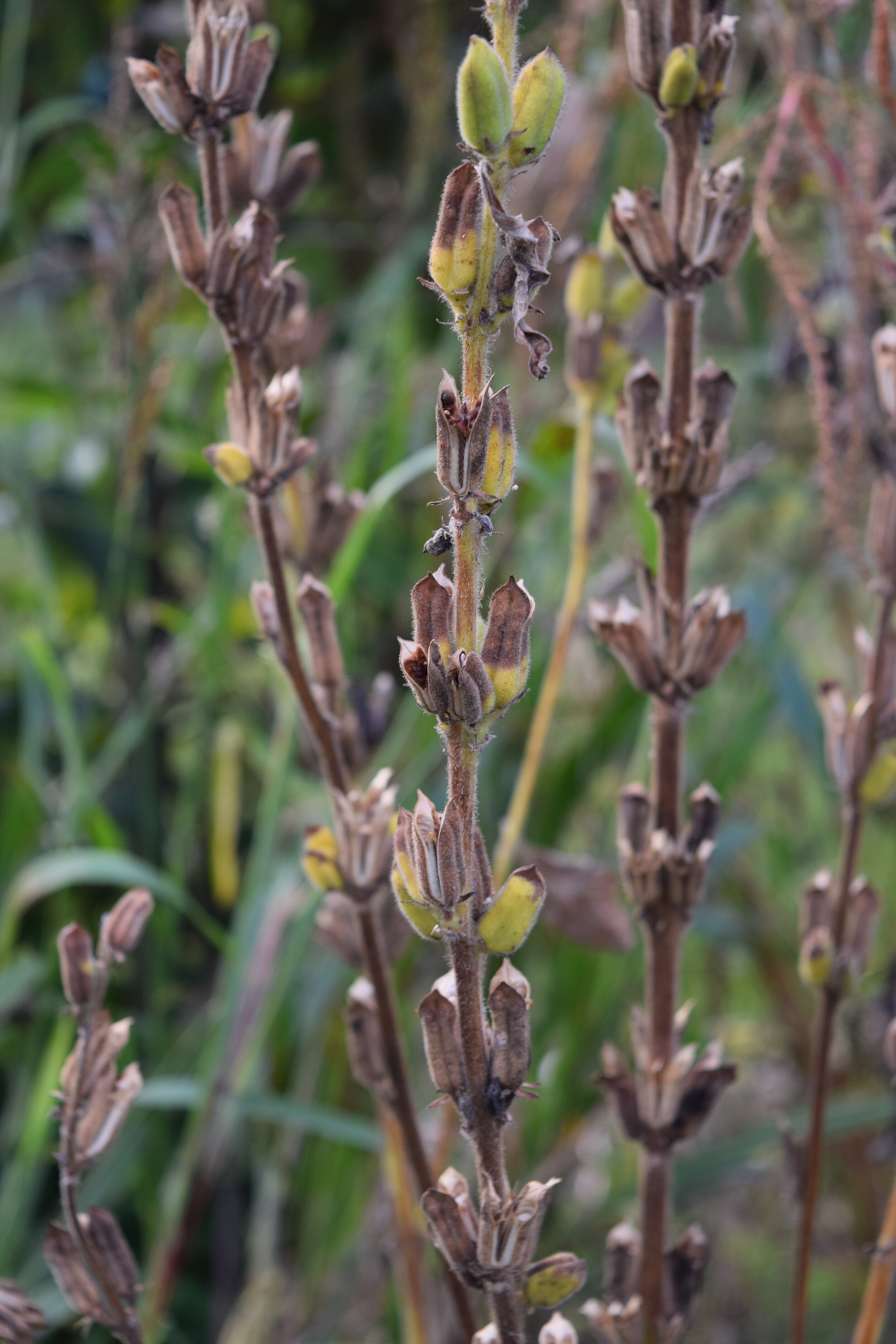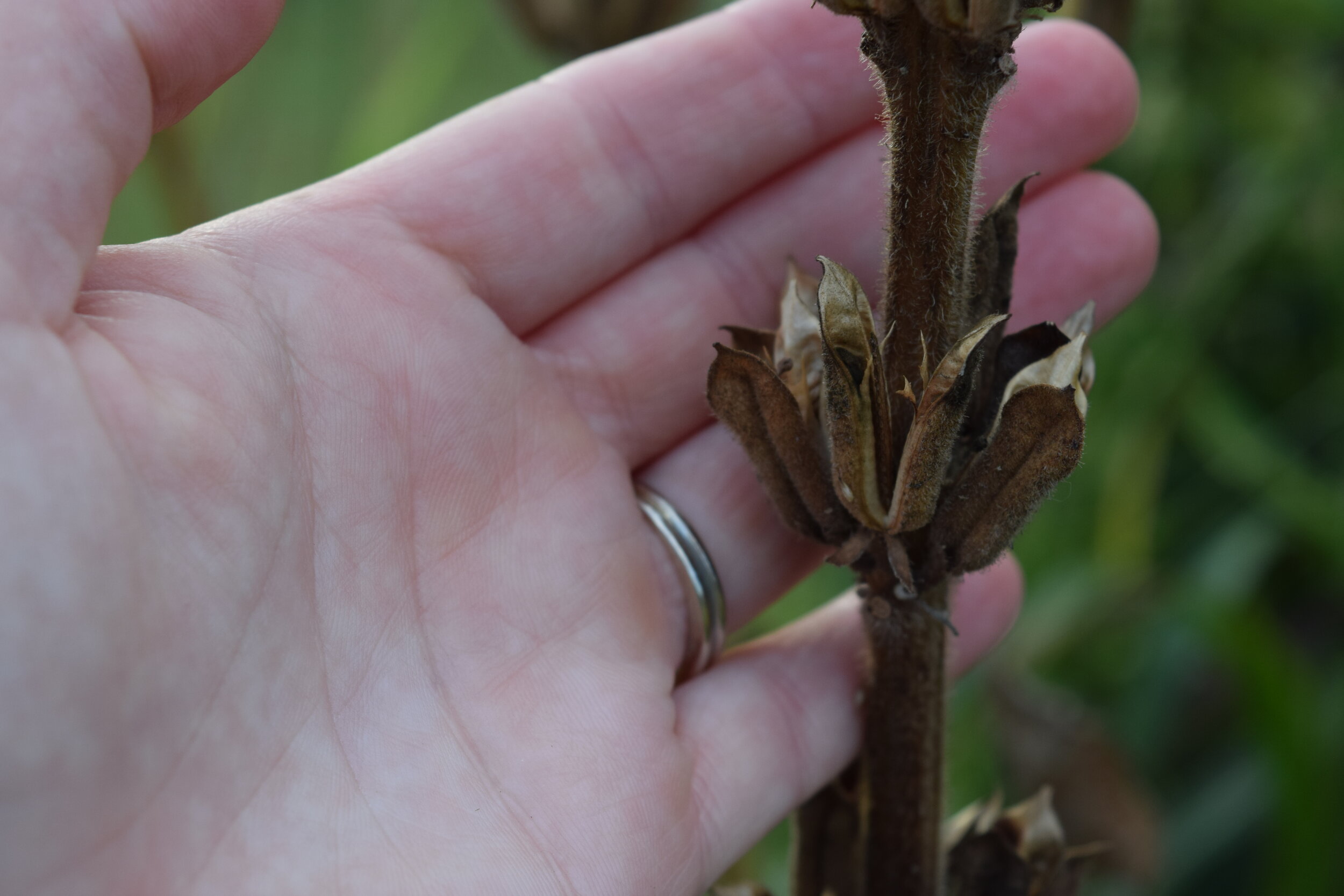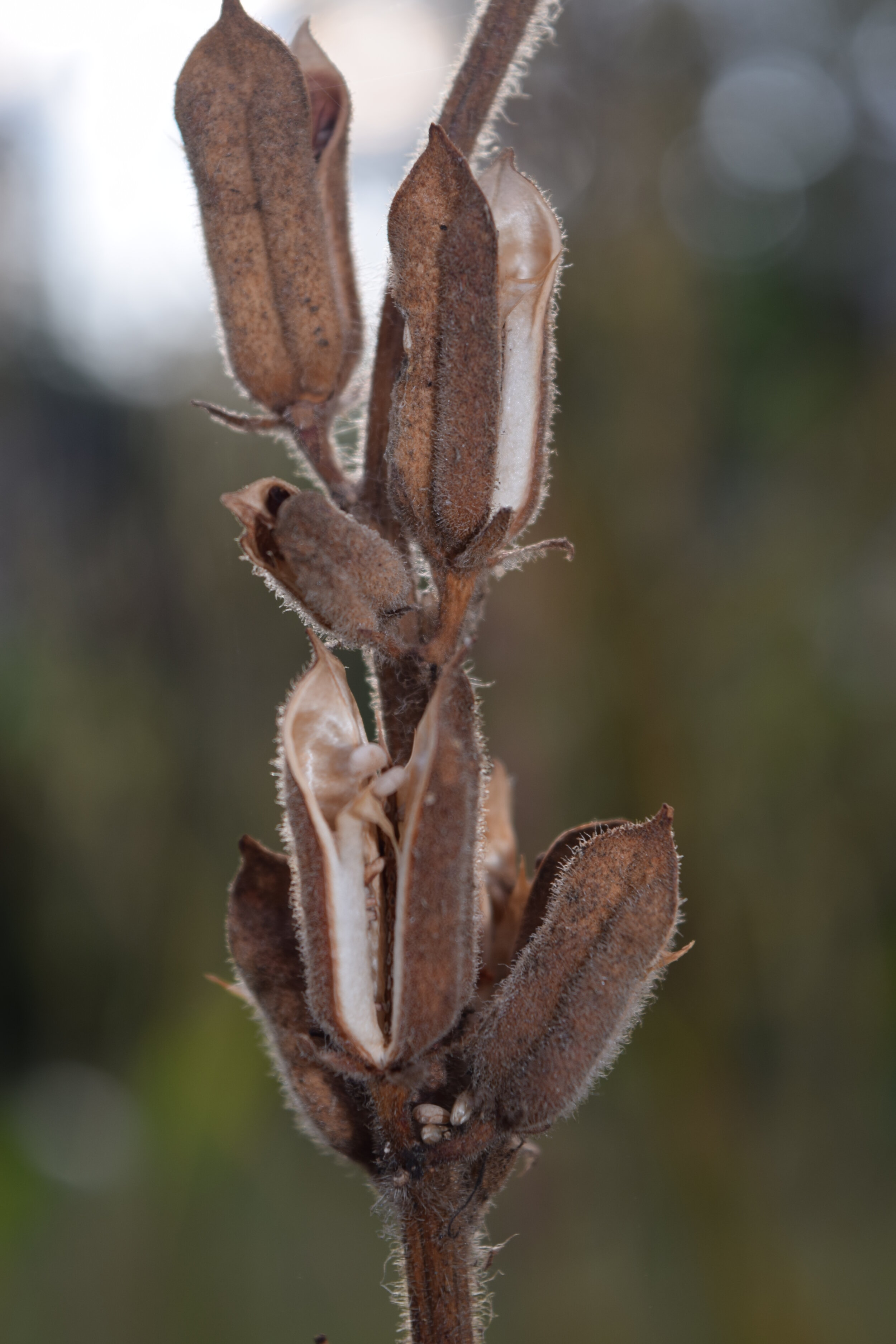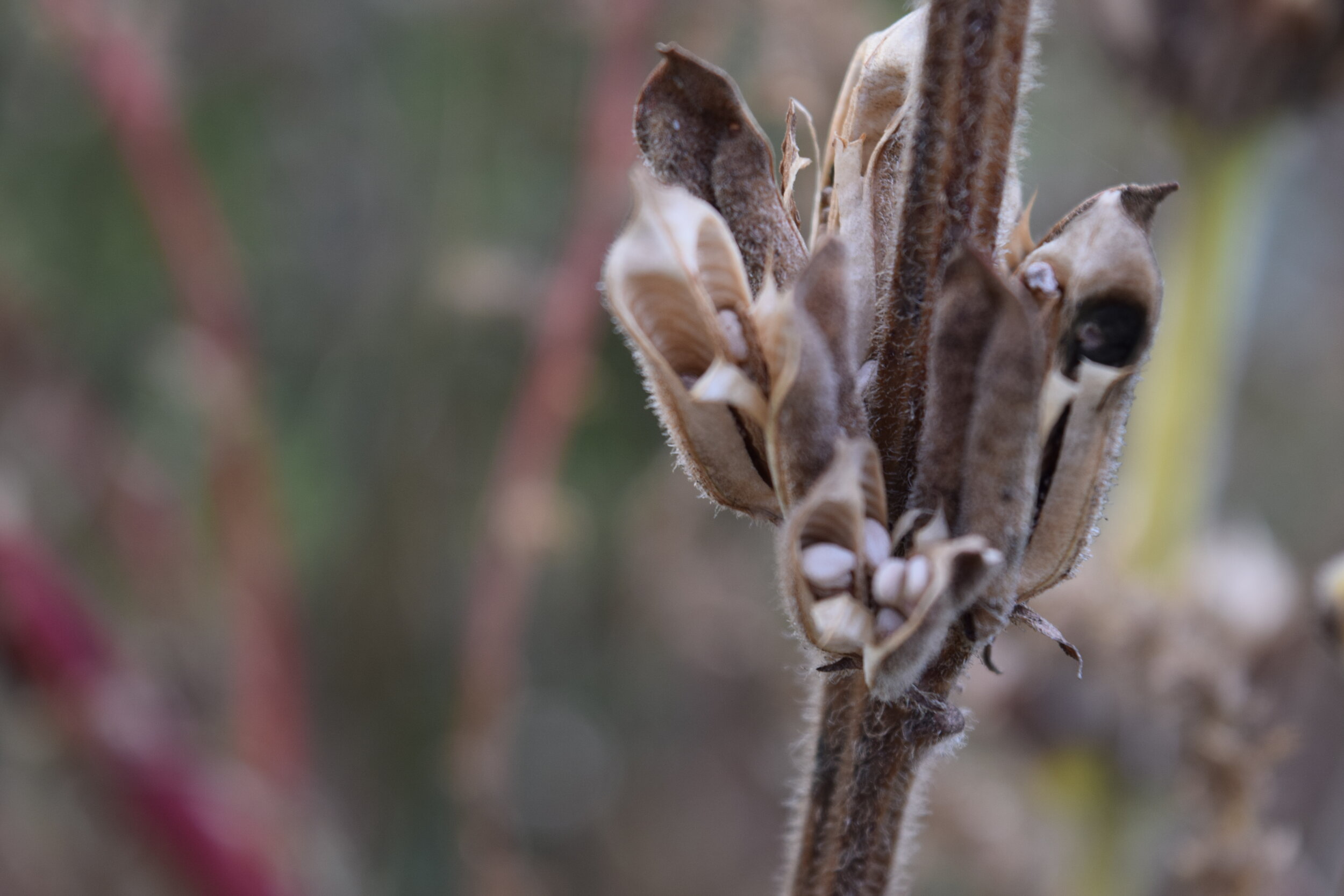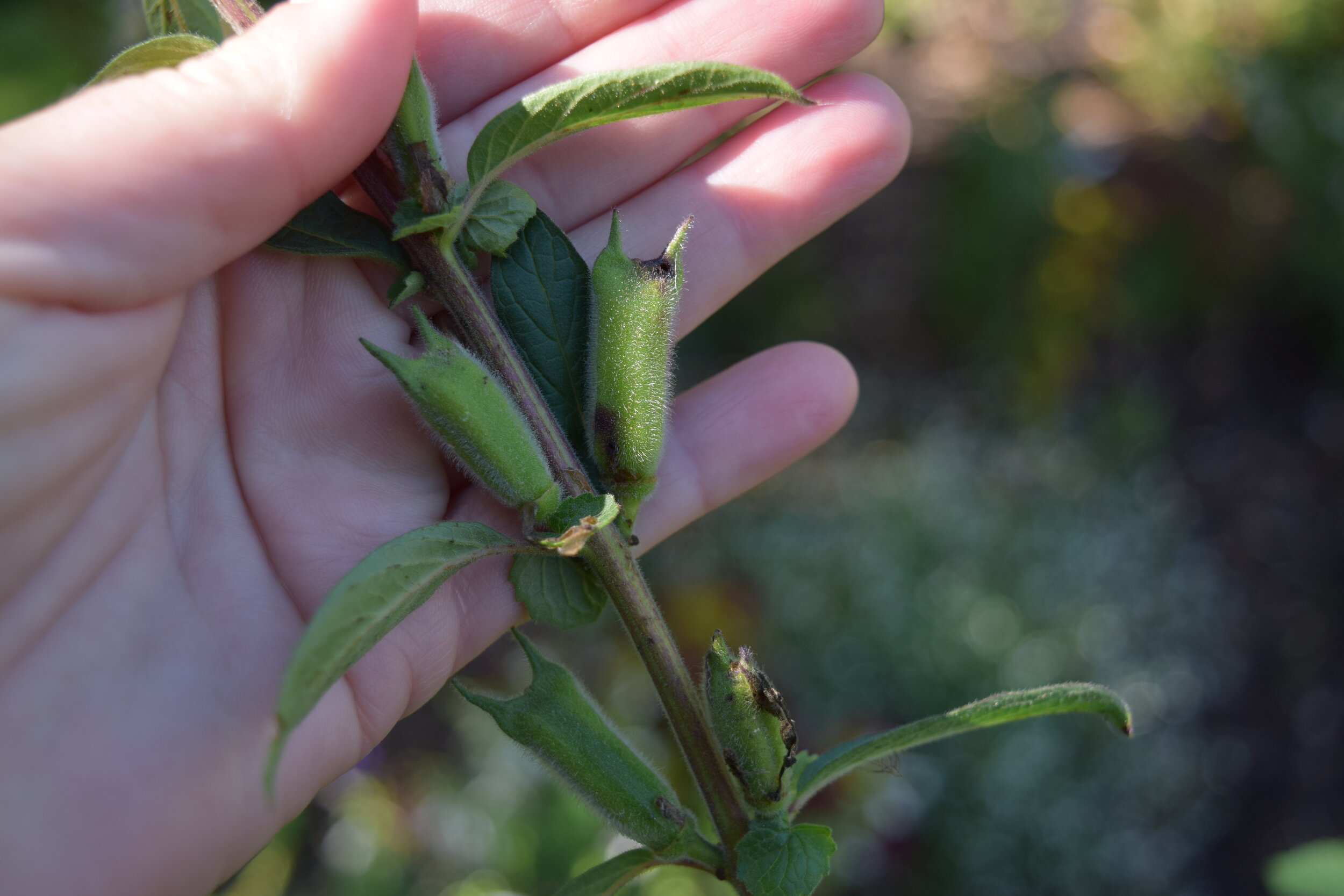A self-sown sesame plant growing well above my head, full of ripening seed pods
Sesamum indicum
Have you ever grown sesame?
Probably the most underutilized plant of this era, sesame is hands down my favorite summer annual. I first saw this planted at Monticello and was immediately fascinated. I had never seen sesame before; in fact, I don’t think I had ever thought about sesame as a plant. It was just that seed on hamburger buns. Once I saw it I feel deeply in love and wouldn’t be satisfied until I grew it myself. After all, if Thomas Jefferson thought it was a garden worthy plant, who was I to not follow his lead?
Sesame seed at Monticello ripening through the autumn season
Turns out this native to India is an ideal plant for hot, humid regions and can reach upwards of 6’ tall in good soil. It blooms all summer and looks like a foxglove on steroids!
Sesame is a warm season annual, just like marigolds or zinnias, from the Pedaliaceae plant family. Sow the seeds after the soil has had a chance to warm up- ideally to 50F. Here in central North Carolina USDA zone 7 I direct sow seeds anytime between Memorial day and Fourth of July.
Grow in FULL SUN if you want the plants to be super productive. I have a few specimens that get only a few hours of direct light and they are half the size of the plants growing in full exposure. Also recognize that sesame is best planted in the mid- back of your borders, as it can grow very tall. Most of the plants in my garden are well above my head now, thanks to the healthy Soil3 organic compost they grow in.
Sesame is very versatile and can be grown as a transplant or from direct seeding. I recommend direct seeding as it is the easiest way to make a big impact. If you are transplanting sesame space it about 12-15” apart to allow for maximum development.
Now that it is well established in my garden, I find seedlings coming up on their own and, if growing in the wrong spot, can be moved with little effort. Even though I take care to harvest the seed for culinary use and to share with others, a “few” (hundred) always manage to drop and germinate the following season. This is an attribute I am very fond of.
Pink flowering sesame produces black seed. This is actually Sesamum radiatum.
White flowering sesame produces white seed. The botanical name for this is Sesamum indicum.
Sesame will bloom all summer- pink blooms indicate the species S. radiatum, which will have dark seed; white flowers are from the traditional S. indicaum and will result in traditional “hamburger bun” seeds. I have both, and likely they have hybridized courtesy of the many pollinators, especially bees, who visit the plants throughout the garden.
One of the greatest advantages that sesame offers is that the animals LEAVE IT ALONE! Literally, the deer, rabbits and groundhogs will eat every plant surrounding the sesame, but due to it thick, somewhat hairy foliage that has an undesirable flavor, you will never see your plants munched to the ground.
In my home foodscape, self sown sesame provides a “cat jungle” where I imagine Ava and Sophia get in touch with their inner lioness.
Botanical Basics
White flowering/ seed sesame
Sesamum indicum is the traditional cultivated type, also referred to as benne. It is widely naturalized in tropical regions around the world and is grown for its edible seeds, which grow in pods. Leading world producers include Tanzania, Myanmar, India, and Sudan.
Sesame seed is one of the oldest oilseed crops known, domesticated well over 3000 years ago and has the distinction of having the highest oil content of ANY SEED! It is also remarkably drought tolerant, growing in conditions where other crops fail.
It is a plant I highly recommend incorporating into your landscape simply for its ease of growing and long term beauty. It is an elegant, low maintenance summer annual.
THE TRICK IS SOURCING SEED…
which I am working on.
Sesamum radiatum is a closely related to traditional sesame, except it has darker pigmentation. It is known as black benniseed or black sesame and is native to west and central Africa where it has been cultivated since ancient times. It grows just like S. indicum, and in my experience the two can cross pollinate easily.
I originally got my seed from Baker Creek Heirloom Seed, but they are not longer offering it- the search continues.
Harvesting Sesame Seed
As fall approaches, the seeds of both of these species will develop along the tall stalks and ultimately turn brown when fully ripe. Harvesting can be tedious. My recommendation is to wait until the stalks are completely dry, then simply cut the stalk off at ground level and shake the seed out into a bucket. From here you can roast the seed at a low temperature and add to breads, salads, and other meals, or process the seed into oil or tahini, depending on how ambitious you are! Not interested in eating your homegrown sesame? That is okay! Just store the raw, uncooked seed in a plastic bag in your refrigerator through the winter and use it to plant the following season! If you are anything like me, you will have plenty to share with the gardeners in your life.
Connecting a few more botanical dots
A few weeks ago, I noticed that a different plant in my foodscape, Ceratotheca, looked very similar to sesame, and I started wondering if the two were related. That of course led me down a giant rabbit hole where I discovered a few interesting things that I would love to share with you.
Ceratotheca triloba is a beautiful summer flowering annual plant that I have grown for the past 20 years. I was first introduced to this self sowing annual while working at Montrose Gardens, where it would deposit seed into the gravel beds of the scree garden. The blooms would range in color from pink to white and I used to call it a southern hollyhock. Beyond that I never thought much about where it was from and what potential uses it had, other than the pretty blooms withstood the Carolina heat and humidity.
Turns out, the “wild foxglove” is also in the Pedaliaceae plant family- hence it’s close relation to sesame. It is native to areas of South Africa that receive summer rainfall, especially grasslands, and is considered to be an “opportunistic annual”, because it germinate best in disturbed areas like roadsides. Suddenly my early experiences with this plant started to make sense!
It has a slightly shorter growing stature than sesame, at least it does here in my foodscape. It seems to only seed along bed edges, which is quite annoying, but I love the plant so I leave it alone. Here it grows about 2.5’ tall, with half that being the elongated flower stalk. It generally starts to bloom in early August and will continue until frost.
Bees are the main pollinator- specifically carpenter and honey bees. They crawl up into the flower, get covered with pollen and then move to the next flower, gathering nectar while ensuring seed will develop. The funny thing about plants like sesame and Ceratotheca is they don’t ever have a ton of flowers open at once. Rather they have a few blooms but continue producing for many months.
The seed pods of Ceratotheca have horns
The botanical word Ceratotheca translates to “horned capsules” from the Greek kerato = horned and theke = case. Small black seeds are formed in the fruits which have two very prominent horns at their tips. Within a few weeks of flowering the green fruits turn brown and dry, splitting open to release the flat, pear shaped seeds.
Since I only have the pink flowering variety, I placed an order from Plant World Seeds for the white flowering form ‘Alba’
Just like sesame, the animals steer clear! The leaves, stems, and flowers are covered in fine white hairs. The plants are slightly sticky and when crushed give off a strong, unpleasant smell. The flowers last for a few days in a vase.
Interestingly, Cerathotheca triloba is used in traditional medicine to treat painful menstruation, stomach cramps, nausea, fever, and diarrhea. Though I simply grow it because it is pretty.
But there is more…
Ceratotheca sesamoides is a flowering plant that I have never grown or seen, to my knowledge, but because of this exploration I now am determined to grow in 2021. It is commonly referred to as “false sesame” because it is so similar to Sesamum indicum.
Natively, it is found in the African Savannah and other semi-arid, tropic and sub-tropic regions, usually growing in sandier soils south of the Sahara. It can be identified by numerous hairs on the stem, its pink flowers often replete with brown and purple dots and a sub-erect growth habit.
This is a plant with many practical uses, and actually falls into the category as a FAMINE FOOD, per my alma mater, Purdue. The leaves and flowers can be eaten as vegetables or used in sauces, while the seeds can produce cooking oil. Despite its many uses the plant remains predominantly underused and undervalued.
The problem, as with all of these plants, is finding a reliable seed source. It is my mission to find some, grow it and start collecting my seed so one day I can distribute cool plants that are easy to grow to interested gardeners.
Overall sesame, and its relatives are wonderful plants that belong in your garden! I don’t know why they never made their way into the nursery industry- I hope to change that one day. My recommendation, if you find viable seed BUY THEM, SOW THEM, GROW THEM, and SHARE THEM! And don’t forget to take a few (hundred) photos along the way!





